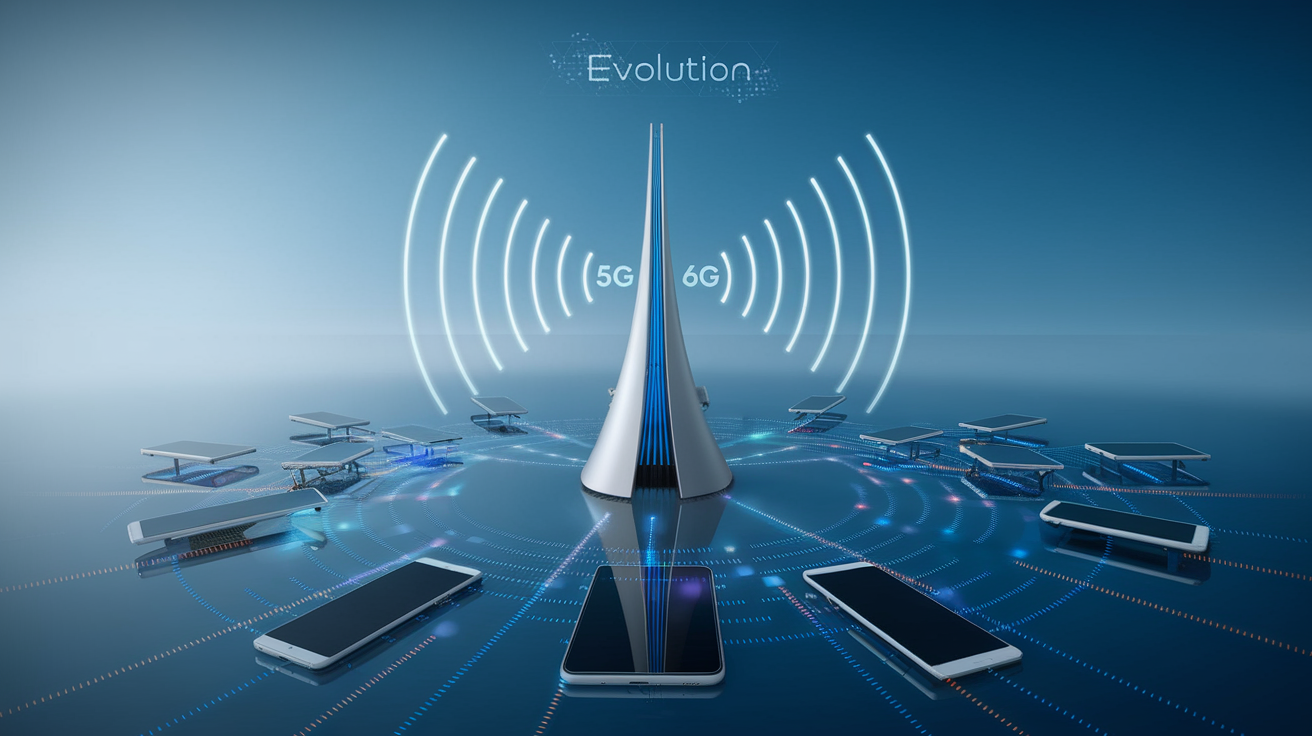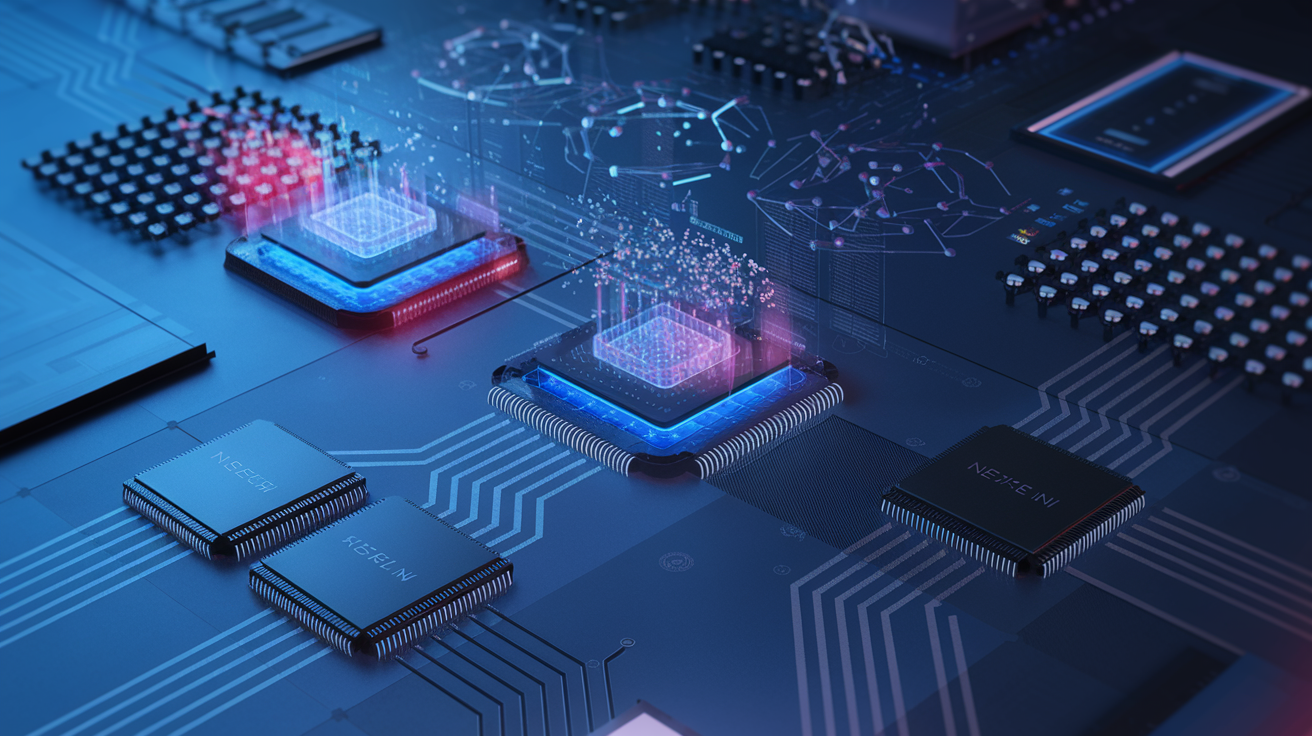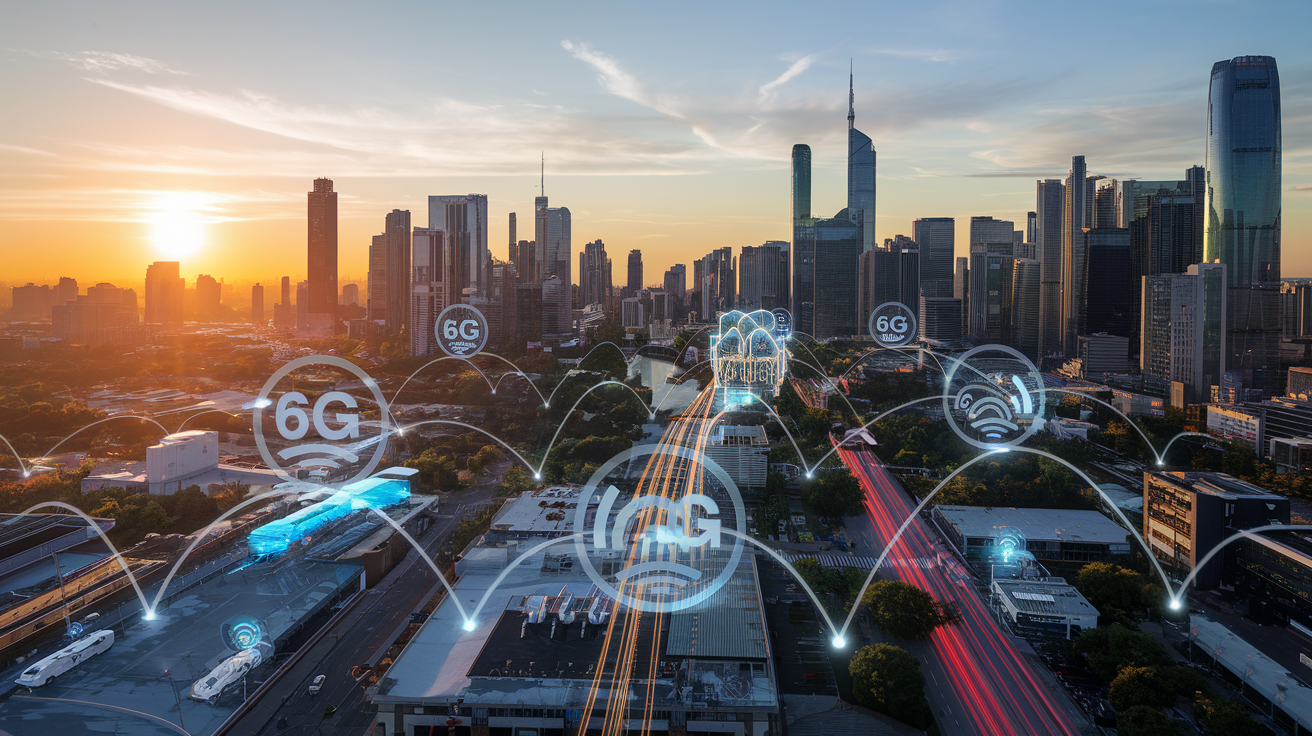As 5G networks continue their global rollout, tech visionaries are already setting their sights on the next frontier of connectivity: 6G. Imagine downloading entire seasons of your favorite shows in seconds, experiencing truly immersive virtual worlds with zero lag, or witnessing autonomous vehicles communicating instantaneously across smart cities.
With promised speeds of up to 1,000 Gbps (that’s 100 times faster than 5G!) and latency measured in microseconds rather than milliseconds, 6G isn’t just an incremental step forward—it’s poised to fundamentally transform how we interact with technology and each other.
The implications stretch far beyond faster downloads. 6G will serve as the backbone for revolutionary applications in healthcare, education, and entertainment through advanced holographic communication and extended reality experiences.
It will integrate deeply with artificial intelligence, support up to ten million connected devices per square kilometer, and even incorporate quantum computing technologies to enhance cybersecurity.
While full deployment isn’t expected until the early 2030s, the groundwork being laid today will reshape our digital landscape for decades to come.
Join us as we explore the evolution of wireless technology, breakthrough performance metrics, transformative underlying technologies, revolutionary applications, and industry-specific impacts that will define the 6G era.
Understanding 6G: Evolution, Not Revolution

From 5G to 6G: The Evolutionary Path
The journey from 5G to 6G represents a transformative leap in telecommunications technology, building upon the foundation laid by previous generations. Unlike a complete overhaul, 6G emerges as a natural progression that enhances and expands existing capabilities.
This evolution will enable networks to reach unprecedented speeds of up to 1 terabit per second, coupled with ultra-low latency measured in microseconds.
What truly distinguishes 6G from its predecessors is the integration of artificial intelligence throughout its architecture. These networks will possess the ability to self-optimize and adapt to user behavior, creating a more responsive and efficient communication ecosystem.
This AI integration will be fundamental to supporting advanced applications like real-time holographic communication and remote surgeries.
Timeline for 6G Development and Deployment
The roadmap for 6G development follows a carefully structured timeline divided into three key phases:
- Initial Research and Ideation (2020-2025): This foundational phase focuses on conceptual development and preliminary research.
- Prototyping and Standardization (2025-2030): During this critical period, prototypes will be tested and global standards established.
- Commercial Deployment (2030-2035): The culmination of these efforts will result in the global rollout of 6G networks. According to established timelines, the first commercial 6G systems are expected to be introduced by 2030.
Each phase builds upon the previous one, addressing significant challenges related to terahertz frequencies, energy efficiency, and creating cohesive global standards.
Global Collaboration on 6G Standards
The development of 6G standards necessitates unprecedented international cooperation. The ITU plays a crucial role in standardizing technologies for International Mobile Telecommunications, with the IMT-2030 classification being essential for accessing globally recognized frequency bands and facilitating a worldwide commercial ecosystem for 6G.
In parallel, the 3rd Generation Partnership Project (3GPP) has committed to developing 6G specifications with a timeline closely aligned with ITU’s.
Their work begins in 2024, with requirements and specifications developed across multiple releases, culminating in the first versions by the end of 2028 to prepare markets for 2030 deployment.
The 3GPP process involves several distinct phases:
- Study items to explore feasibility
- Work items serving as task lists for projects
- Technical specifications outlining implementation rules
- Standards ensuring global interoperability among devices and networks
Key principles guiding 6G development include establishing a truly global standard supporting new use cases, efficient spectrum sharing with 5G, and creating a smooth migration path.
The emphasis on open interfaces will promote a healthy ecosystem, while energy efficiency remains a critical consideration.
Now that we understand the evolutionary nature of 6G and its development trajectory, let’s examine the breakthrough performance metrics that will define this next-generation network technology and how they will transform our digital experiences.
Breakthrough Performance Metrics

Unprecedented Speed: Up to 1,000 Gbps
Remember when 5G blew our minds with its gigabit speeds? 6G is about to make that look like dial-up. We’re talking about theoretical speeds up to 1,000 Gbps (that’s 1 terabit per second).
To put this in perspective:
- 5G: 10-20 Gbps peak speeds
- 6G: Up to 1,000 Gbps peak speeds
With these speeds, you could download 142 hours of Netflix content in one second. That’s an entire season of your favorite show before you can even say “binge-watching.”
Ultra-Low Latency: Microseconds Response Time
6G networks aim to slash latency to the microsecond range—about 100 times faster than 5G.
5G latency: 1-10 milliseconds
6G latency: 10-100 microseconds
This isn’t just about gaming. This microscopic delay enables truly real-time applications where even milliseconds matter:
- Remote surgery with zero perceptible delay
- Autonomous vehicles communicating instantly to avoid collisions
- Financial transactions executing at unprecedented speeds
Massive Capacity: Supporting 10 Million Devices per Square Kilometer
The connection density of 6G networks will be mind-boggling—supporting up to 10 million devices per square kilometer. That’s 10x what 5G can handle.
This massive capacity isn’t just about connecting more phones. It’s about enabling:
- Smart cities with millions of sensors on every block
- Industrial IoT with sensors on every machine part
- Environmental monitoring networks with unprecedented detail
Enhanced Reliability and Security Features
6G won’t just be faster—it’ll be smarter and more secure. The network will incorporate:
- AI-native architecture that self-optimizes in real-time
- Quantum encryption methods to make hacking virtually impossible
- Distributed intelligence that can detect and neutralize threats automatically
- Self-healing network capabilities that reroute data instantly when connections fail
These security features aren’t optional add-ons—they’re baked into the core architecture from day one, addressing the shortcomings of previous generations.
Transformative Technologies Powering 6G

Now that we’ve explored the breakthrough performance metrics that will define 6G networks, let’s examine the underlying technologies that will make these impressive capabilities possible.
Advanced Wireless Communication Using High-Frequency Bands
The transition from 5G to 6G will necessitate exploration of previously untapped frequency spectrums. Communications at Terahertz and optical frequencies represent a crucial innovation for 6G development, enabling ultra-high-speed broadband access that far surpasses current capabilities.
These high-frequency bands will provide the foundation for the unprecedented data rates and bandwidth that future applications will demand.
Quantum Computing Integration for Enhanced Security
6G will address rising security challenges by using quantum computing to create secure communication channels resilient against advanced future threats.
This integration forms part of the intelligent network architecture essential for 6G, helping to create robust systems capable of handling sensitive data with appropriate protection mechanisms.
AI-Driven Network Management and Optimization
The establishment of intelligent networks represents another pivotal innovation for 6G. Artificial intelligence will be deeply embedded within network infrastructure, enabling autonomous optimization, predictive maintenance, and dynamic resource allocation.
These capabilities will streamline network management processes and significantly reduce operational costs, allowing for the complex orchestration of resources needed to support the demanding KPIs of 6G systems.
Energy Harvesting and Sustainability Innovations
Environmental considerations form a critical component of 6G development. Future networks must operate within economic, social, technological, and environmental contexts anticipated by 2030.
Energy harvesting technologies will enable network components to be more self-sufficient, reducing the carbon footprint of increasingly dense network deployments.
This sustainability focus aligns with the holistic approach to network design that considers not just performance but also long-term viability.
With these transformative technologies providing the foundation for 6G networks, we can now turn our attention to the revolutionary applications that will be enabled by these advancements.
These use cases will demonstrate how the theoretical capabilities of 6G will translate into practical solutions across various industries and everyday scenarios.
Revolutionary Applications Enabled by 6G

Now that we’ve explored the transformative technologies that will power 6G networks, let’s examine how these advancements will enable revolutionary applications that will fundamentally change how we interact with technology and each other.
Extended Reality (XR): Immersive AR, VR, and MR Experiences
The Next G Alliance identifies Multisensory Extended Reality as one of the primary categories of 6G use cases. Mixed Reality (MR) applications will create truly immersive experiences by seamlessly blending digital content with our physical environments.
Unlike today’s limited XR applications, 6G will support multiplayer gaming and collaborative environments requiring robust connectivity and ultra-low latency.
Bandwidth requirements are projected to increase to 50Mbps per player, which only 6G networks will be able to reliably deliver, ensuring smooth, real-time interactions in these virtual and augmented spaces.
Real-Time AI and Machine Learning Applications
AI Communication represents a significant advancement enabled by 6G. The integration of artificial intelligence with communication networks will enhance user experiences through intelligent assistance and content generation.
These applications will require high-performance connectivity to support seamless integration while maintaining privacy.
6G will serve as an intelligent, programmable platform that can handle the massive computational demands of distributed AI systems operating in real-time across vast networks.
Holographic Communication and Digital Twins
Massive Digital Twin technology will connect detailed digital models with physical systems, enabling real-time monitoring and management across various industries.
This advancement goes beyond current digital twin implementations by creating holographic representations that can be manipulated and interacted with in real-time.
The Spatial Data use case will expose geographic information as APIs, enabling applications that rely on accurate positioning and environmental data to create precise holographic representations of physical spaces and objects.
Seamless Global Connectivity Without Coverage Gaps
The Global Internet initiative uses 6G with terrestrial and satellite networks to provide seamless, reliable broadband coverage worldwide, including remote areas.
This seamless connectivity will be particularly crucial for Critical Services that require guaranteed service levels and resilience through advanced network features, including self-healing capabilities and satellite support as fallback options.
With these revolutionary applications in mind, next we’ll explore the specific industry impacts and use cases that will be transformed by 6G technology, from healthcare to manufacturing to smart cities.
Industry Impact and Use Cases

With 6G’s revolutionary potential, we’ll explore its impact on industries and the creation of previously unimaginable new use cases.
The FMG Login 6G Roadmap for Vertical Industries published in April 2023 provides valuable insights into how 6G will reshape multiple sectors.
This comprehensive report highlights the demand-side expectations, challenges, and opportunities across eight industry verticals, with particular focus on areas like agriculture and smart cities.
Healthcare: Remote Surgery and Real-Time Diagnostics
The 6G network’s ultra-low latency and enhanced reliability will revolutionize healthcare delivery. Medical professionals will be able to perform remote surgical procedures with unprecedented precision, breaking down geographical barriers to specialized care.
Real-time diagnostics powered by 6G will enable instant analysis of patient data, allowing for faster treatment decisions and improved patient outcomes.
Transportation: Autonomous Vehicles and Smart Infrastructure
The transportation sector stands to benefit enormously from 6G capabilities. Autonomous vehicles will communicate with each other and with smart infrastructure in real-time, drastically improving safety and efficiency.
The roadmap highlights how 6G will enable vehicles to process vast amounts of environmental data instantaneously, creating truly intelligent transportation systems that can adapt to changing conditions.
Smart Cities: Intelligent Systems and Services
According to the roadmap, smart cities represent one of the key verticals that will be transformed by 6G technology. Intelligent systems will optimize resource allocation, reduce energy consumption, and enhance public services.
6G networks will connect countless IoT devices and sensors throughout urban environments, creating a seamless digital ecosystem that responds to citizens’ needs proactively rather than reactively.
Entertainment: Immersive and Interactive Experiences
6G will enable immersive, interactive entertainment with high bandwidth and low latency, supporting advanced AR/VR and blending digital-physical experiences.
The roadmap emphasizes that realizing these transformative opportunities will require cross-sector partnerships among entrepreneurs, academic institutions, industry organizations, and government policymakers.
The National Governors Association (NGA) is positioned as a key facilitator in advancing these collaborative initiatives and ensuring that the benefits of 6G extend across all sectors of society.

Looking Ahead to a 6G Future
While 5G continues its global rollout, the foundations of 6G are already being laid through collaborative efforts between tech companies and governments worldwide.
6G’s ultra-fast speed, low latency, and massive connectivity will power transformative applications like holograms and XR across multiple industries.
The true power of 6G lies in its integration with quantum computing, AI, and sustainable energy technologies, creating a network that’s not only faster but smarter and more environmentally responsible.
6G, expected by the 2030s, will blur physical-digital boundaries, driving innovation and shaping the foundation of our digital future.

Pingback: Blockchain vs. Traditional Banking: Which is More Secure? 2025